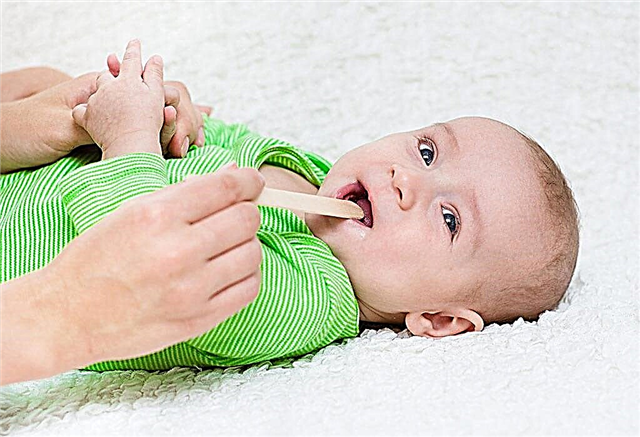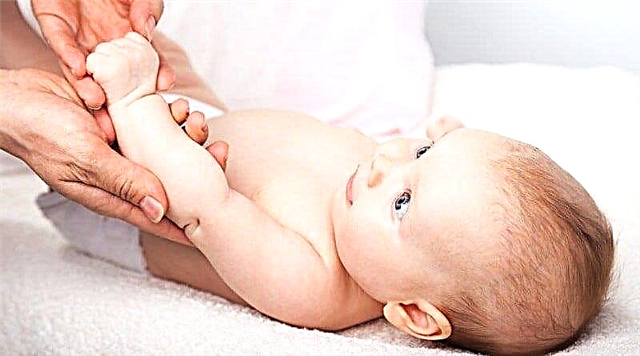A newborn baby for a mother is the most beautiful thing in the world. She is not embarrassed that her born child has a slight deformation of the head. She understands that during childbirth, the baby has a hard time moving along the birth canal, and his head is under tremendous pressure. However, the bones of the skull of a newborn have mobility due to the thin shells that connect them. This allows the bones to move, protecting the head during labor.

Head of a naturally born baby
Head circumference at birth
Young mothers often ask the doctor why their baby's head is large in comparison with the little body? In fact, a baby has a head circumference of about 35 cm, and a newborn's head is about a quarter of the baby's body length. If we compare the head with the chest, it is also visually larger. Experts believe that a difference of two centimeters in the first months of a child's life is considered normal. By six months, these dimensions become the same, and by one year, the child's head circumference is 2 cm less than the chest.
Attention! Mothers should know that the head circumference of a one-year-old child should not exceed the chest circumference. If there is a significant discrepancy, you need to see a doctor.
Newborn head shape
Gynecologists note that in a baby, the shape of the head after birth depends on how the baby will be born: naturally or through a cesarean section. In natural childbirth, the head of a newborn can be somewhat pointed or conical, it can be round (brachycephalic), oval elongated (dopichocephalic), flattened, sometimes with edema or a lump (cephalohematoma). It is essentially a large bruise between the skull and skin after the baby has passed through the birth canal during labor. This is completely normal and is not a sign of damage to the skull or brain. The skull may be stretched forward or backward. It all depends on the physiological structure of the mother's birth canal.
Young parents should not worry, whatever the shape of the head, it should soon return to its normal rounded appearance. Any bruising of the scalp or eyelid swelling that occurs during labor will go away by the end of the first week or two. Any red spots on the eyes will disappear in about three weeks. 2-3 months after birth, the skull begins to grow in the transverse direction, and the baby's head takes on a natural look.

Newborn head view
If a baby is born through a cesarean section without going through the birth canal, the head is not under pressure. She has an even, rounded shape in the baby. Its volume may slightly differ from the tabular indicators.
Norms of development of the child's head from birth to one year
An important indicator of the state of health, as well as the correct development of the newborn for an experienced pediatrician, is the size of the head circumference. It is this measurement that measures the growth of a newborn's brain. Therefore, during the monthly examination of the baby, the doctor must measure the circumference of the head, compare it with the indications during childbirth, measurements in the previous month and with the data indicated in the anthropometric table. A significant lag, as well as a lead, in comparison with the tabular data, may indicate a problem in the development of the child. Based on the measurements, the doctor establishes the correct diagnosis and, if necessary, prescribes treatment.
Currently, in many children's clinics, the size of the head circumference of a newborn is measured with a craniometer. This device allows pediatricians to determine not only the circumference, but also the degree of deformation of the infant's skull.

Measuring device - craniometer
Do not ignore the fontanelles on the baby's head. On the top of it is the largest and most visually visible fontanelle. It is localized at the junction of the frontal and parietal bones, has a vague rhombus shape and can reach 3 to 5 cm in diameter (diameter). In a newborn baby, it is the fontanel area that allows the skull to grow in volume. The fontanelle acts as a thermoregulator, allowing excess heat to escape from the brain through a kind of "window leaf" with increased metabolism in it. As the skull grows, the size of the fontanelles changes. The small one, located in the lateral part of the skull, tightens faster. Usually, by the age of three months of the baby's life, this fontanelle is closed. By the age of six months, the large fontanelle begins to close. Complete closure occurs by the age of one and a half years of the child. Analyzing such a measurement as the circumference of the head in newborns, one can understand how quickly or slowly the fontanel closes.
Young parents are often concerned about the size of the fontanelle located at the top of the baby's head. The fontanelle can be small or large. This is primarily due to heredity. In any case, whatever the fontanelle, it will close, doctors do not see a threat to the baby's health. Sometimes a lack of vitamins during pregnancy is the cause of a large fontanelle. To prevent this, doctors strongly recommend saturating the body with a vitamin complex and calcium during pregnancy.
Attention! The size of the fontanelle depends on the time of delivery. A full-term baby has a fontanel size smaller than that of a premature baby.

The fontanelle in a newborn
According to the anthropometric table, broken down by months, the normal head size in newborns is 34-36 cm. Sometimes the head size can be more or less than the norm. Doctors believe that it is not always worth worrying, since the size can be inherited from the parents.
When the head circumference of the newborn is significantly less than 34 cm, doctors attribute this to prematurity. The increase in head circumference coincides with a period of good weight gain in the newborn, by the year the skull reaches normal size.
The type and size of the baby's head may also depend on the diseases of the expectant mother transferred during pregnancy. Obstetricians note that a newborn often gets a birth injury. There are two reasons:
- when the baby's head does not fit into the size of the mother's pelvis,
- with the wrong behavior of the expectant mother, who does not follow the instructions of the midwife during the labor process.
Currently, doctors have methods of treating such newborns. By one year, the consequences of the birth injury are removed, and the size of the baby's head returns to normal.
Deviation from the norm of development
A difficult and dangerous situation for a newborn, when a child accumulates fluid in the cavities of the brain, due to which the volume of the head increases. This disease is called hydrocephalus (dropsy of the brain). It is very rare. The second disease - microcephaly (underdevelopment of the brain) is diagnosed with a very small head. These deviations are found in the early stages of pregnancy during an ultrasound scan, then treatment is started.
Differences in the size of the head of newborn girls and boys
The average circumference of a newborn's head is 35 cm. It increases by about 3 cm per month. Pediatricians note that the size of a child's head depends on his gender. Since boys are usually slightly larger than girls, their heads are larger, although the average difference is less than 1 cm. The table below shows the head circumference of babies depending on how many months the baby is.

Newborn boy and girl
Head circumference by months in infants
| Age | Child's head circumference, cm | |
|---|---|---|
| Boys | Girls | |
| At birth | 35,0 | 34,0 |
| 1 month | 37,3 | 36,6 |
| 2 months | 38,6 | 38,4 |
| 3 months | 40,9 | 40,0 |
| 4 months | 41,0 | 40,5 |
| 5 months | 41,2 | 41,0 |
| 6 months | 44,2 | 42,2 |
| 7 months | 44,8 | 43,2 |
| 8 months | 45,4 | 43,3 |
| 9 months | 46,3 | 44,0 |
| 10 months | 46,6 | 45,6 |
| 11 months | 46,9 | 46,0 |
| 12 months | 47,2 | 46,0 |
As can be seen from the table, an active increase in the child's skull occurs in the first year of life. In the second year of life, its circumference increases on average by 1.5-2 cm, in the third year, the increase in the skull is even slower, the growth is 1-1.5 cm.
Attention! Too intense an increase in circumference, exceeding the norm, should alert parents. In this case, you need to contact a pediatric neurologist for advice.
Does the shape of the head change in newborns?
In addition to the fact that the head of a newborn passing through the birth canal has an irregular shape, it can change after birth as a result of pressure on the back of the head, when the baby lies on the back all the time. This is due to the property of the skull, on which the bones have not yet grown together. It is malleable, and the tendency to hold the head in the same position can lead to irregularities - positional sculpting. It may be most noticeable when viewed from above the baby's head. From this point of view, the back of the head may appear flatter on one side than the other. The ear on the flat side may appear pushed forward.
Positional sculpting, or plagiocephaly, is generally considered a cosmetic issue. Flat spots associated with pressure on the back of the head do not cause brain damage or affect child development. What should young parents do in this case?
After a medical examination, the pediatrician will suggest making changes to the lying position of the child, which will minimize unevenness. This can be a change in the direction of the head when he is lying on the back. It is imperative to turn the baby onto the side, if necessary, place a roller so that the child does not return to the position lying on his back. When feeding, hold the baby so that the head is slightly turned, and does not lie with the back of the head on the mother's hand. There is a recommendation to lay the child on his tummy more often, while the surface on which he lies must be firm.
If the unevenness is not improved by repositioning by 6 months of age, if the baby is over 8 months old, and the deformity is severe, the doctor may prescribe an orthopedic pillow or molded helmet to help shape the baby's head. The custom-fit helmet relieves pressure on the flattened side of the head.

Cast Helmet Hat
Molded helmets are most effective when treatment is started between 4 and 12 months of age, when the skull is still malleable and the brain is growing rapidly. Treatment with a molded helmet is unlikely to be effective after 1 year, when the bones of the skull are fused together and the growth of the head becomes less rapid.
How to find out the girth of the head
Measurements of the head volume up to a year are made by the pediatrician during the monthly examination of the baby. They can be done by young parents on their own to make sure that their child is developing normally. The head measurement is done using a regular tailor's tape. It must be clean and used only for measuring the baby's head. The tape is wrapped around the widest part of the head, along the protruding parts of the skull, through a prominent point on the back of the head and brow ridges. By making such measurements regularly, you can track the dynamics of head growth. The data should be written down in a notebook and then shown to the doctor, since head circumference readings are extremely important, especially in the first year of a baby's life.

Measuring baby's head circumference
To choose a hat - a hat for a child, it is not always necessary to know the volume of the head; it is enough to use the table of the child's growth parameters.
Child's height matching table with hat size
| Height, cm | 50 | 53 | 54-61 | 62-67 | 68-73 |
|---|---|---|---|---|---|
| Cap size | 35 | 36 | 39 | 42 | 44 |
Table of normal values for head circumference
| Child's age | Head circumference, cm |
|---|---|
| Newborn | 33,0 – 36,0 |
| 1 month | 35,0 – 38,0 |
| 3 months | 38,0 – 42,0 |
| 6 months | 42,0 – 45,5 |
| 9 months | 43,5 – 47,5 |
| 1 year | 45,0 – 49,0 |
| 2 years | 47,0 – 50,5 |
| 3 years | 48,5 – 51,5 |
| 5 years | 50,0 – 53,0 |
| 7 years | 50,5 – 54,5 |
| 10 years | 51,5 – 56,0 |
| 14 years old | 52,0 – 57,5 |
Do not lose heart if the measurements of the child's head circumference do not fit into the standard indicators. The head circumference of babies up to five years of age, indicated in the table of normal values, is the average. All children are different. There are limits for the permissible deviations of this indicator, which were established by experts - this is 2.5 cm.If deviations are found, and there is concern about this, you should ask an exciting question to the pediatrician, who, if necessary, will appoint an additional examination with the child. In most cases, the proportionality of the child's body returns to normal by the age of two years.



